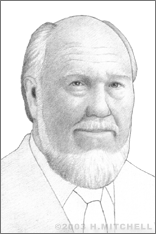Nils Bohlin
Nils Ivar Bohlin, creator of the three-point lap/shoulder automobile seatbelt, was born on July 17, 1920 in Harnosand, Sweden. In 1939, he completed his BS in mechanical engineering at Harnosand Laroveik. In 1942, he began working for Svenska Aeroplan Aktiebolaget (Saab Aircraft Company) as an aircraft designer. There, he was in charge of the development of ejection seats and other pilot rescue systems for supersonic aircrafts.
In 1958, Bohlin was hired as a safety engineer for AB Volvo in Gothenburg, Sweden. In 1959, he became chief of Volvo’s Automotive Safety Department. Bohlin helped to design and manage multi-disciplinary accident investigation teams for cars and trucks. Safety belts were in use at the time, but the most prevalent design used a single strap with a buckle over the stomach. This design risked injury to body organs in high-speed crashes.
Bohlin aimed to find an alternative design that would not only protect both the upper and lower body, but would also be comfortable and simple to use. He spent about a year devising a system that had one strap that would go across the chest and one that would go across the hips, with a joint for these two straps located just next to the driver’s hip. The design held both the upper and lower body in place and was simple enough that the driver could buckle up with one hand.
In 1959, Volvo became the first automaker to introduce Bohlin’s three-point safety belt design. At first, the company put the belts in cars designated only for its home market, but by 1963, all Volvos came equipped with front seat belts, and the company decided to make the design free for use by all car makers.

In 1967, Bohlin presented a paper on behalf of Volvo at the 11th Stapp Car Crash Conference, called "A Statistical Analysis of 28,000 Accidents with Emphasis on Occupant Restraint Value." The report claimed that the belt had already saved thousands of lives, reducing the risk of injury or death in car accidents by as much as 75 percent. This report helped inspire the United States’ National Highway Safety Bureau to implement a law requiring automakers to equip the front seats in passenger cars with three-point lap/shoulder belts. It persuaded a number of other national governments to do the same.
Since its introduction, the three-point shoulder/lap safety belt has changed very little in its overall design. Improvements to the design include the additions of the inertial reel, tensioners to eliminate slack, force limiters to control the force needed to restrain the user, and better buckles. As of today, the U.S. National Highway Traffic Safety Administration estimates that the belts reduce the risk of deaths in car crashes by at least 45 percent.
In 1969, Bohlin was assigned to the Central Research and Development Department at Volvo. Later, he was named Chief Research Engineer in the Advanced Engineering Department. He consistently managed matters related to general automotive safety, including initiating and managing Volvo’s Traffic Accident Research Group. Bohlin retired from Volvo in 1985. He earned several patents during his lifetime related to both aviation and automotive design and was recognized with numerous awards and honors.
In 1974, Bohlin was awarded The Ralph H. Isbrandt Automotive Safety Engineering Award. He was honored in 1979 and 1985 by the National Highway Traffic Safety Administration in Washington, D.C. In 1995, he received a medal from the Royal Swedish Academy of Engineering Sciences. In 2002, he was inducted into the U.S. National Inventors Hall of Fame. On the day he was to be honored for this achievement, Bohlin died at age 82 on September 26, 2002.


